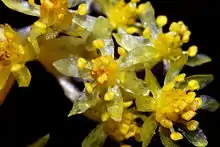Sassafras randaiense
Sassafras randaiense is a species of deciduous tree in the family Lauraceae belonging to the genus Sassafras. It is a relict species endemic to Taiwan. It is threatened by habitat loss.[1]
| Sassafras randaiense | |
|---|---|
 | |
| Scientific classification | |
| Kingdom: | Plantae |
| Clade: | Tracheophytes |
| Clade: | Angiosperms |
| Clade: | Magnoliids |
| Order: | Laurales |
| Family: | Lauraceae |
| Genus: | Sassafras |
| Species: | S. randaiense |
| Binomial name | |
| Sassafras randaiense (Hayata) Rehder | |
| Synonyms[2] | |
| |
Classification
Sassafras randaiense is treated by some botanists in a distinct genus as Yushunia randaiensis (Hayata) Kamikoti, though this is not supported by recent genetic evidence, which shows Sassafras to be monophyletic.[3][4]
Description
Sassafras randaiense is a medium-sized deciduous tree. The leaves are alternate, rhomboid-ovate, 10–15 cm long and 5–6 cm broad, and are glabrous above and glaucous beneath. The leaf shape is variable, with most leaves simple (entire) without lobes, but 2 to 3-lobed leaves can be found on some trees, a feature it shares with the North American species S. albidum and †S. hesperia. The leaves of S. randaiense have an acute apex, and the leaf base is acute or obtuse. The flowers are hermaphroditic[5] and subterminal, in panicles that are 3 cm long. The fruits are globose, 6–7 mm across, and are attached on a thickened pedicel 2.5–3 cm long. Flowering occurs usually in February with fruit maturing in October. S. randaiense is found in broad-leaved forests from 900 to 2,400 m throughout the island of Taiwan.[6]
Distinguishing characteristics from Sassafras albidum
Along with Sassafras tzumu, Sassafras randaiense is distinguished from the North American Sassafras albidum and extinct Sassafras hesperia by some important characteristics, including that they may have both male flowers and female flowers on the same tree, while the North American species are dioecious (individual plants bear only male or only female flowers). Molecular data also shows some differences between the Chinese and North American species.[7][8]
References
- Lu, S.Y.; Pan, F.J. (1998). "Sassafras randaiense". IUCN Red List of Threatened Species. 1998: e.T31248A9619639. doi:10.2305/IUCN.UK.1998.RLTS.T31248A9619639.en. Retrieved 17 November 2021.
- "Tropicos.org".
- Nie, Z.-L.; Wen, J. & Sun, H. (2007). "Phylogeny and biogeography of Sassafras (Lauraceae) disjunction between eastern Asia and eastern North America". Plant Systematics and Evolution. 267 (1–4): 191–203. doi:10.1007/s00606-007-0550-1. S2CID 44051126.
- Kamikoti, S. (1933). Ann. Rep. Taihoku Bot. Gard. 3: 78
- Chung, Kuo-Fang; Van Der Werff, Henk; Peng, Ching-I. (2010). "Observations on the Floral Morphology of Sassafras randaiense (Lauraceae)1". Annals of the Missouri Botanical Garden. 97: 1–10. doi:10.3417/2008029. S2CID 54054858.
- Liao, Jih-Ching (1996). "Lauraceae". In Huang, Tseng-chieng (ed.). Flora of Taiwan. Vol. 2 (2nd ed.). Taipei, Taiwan: Editorial Committee of the Flora of Taiwan, Second Edition. pp. 433–499. ISBN 957-9019-52-5. Retrieved 29 March 2013.
- Zhengyi, Wu; Raven, Peter; Deyuan, Hong, eds. (December 9, 2008). Flora of China, Menispermaceae through Capparaceae. Vol. 7. Missouri Botanical Garden Press. p. 159. ISBN 978-1930723818.
- Zhou, Jiaju; Xie, Guirong; Yan, Sinjian (March 7, 2011). Encyclopedia of Traditional Chinese Medicines - Molecular Structures, Pharmacological Activities, Natural Sources and Applications: Vol. 2: Isolated Compounds D-G. Vol. 2. Springer. p. 321. ISBN 978-3642167379.
